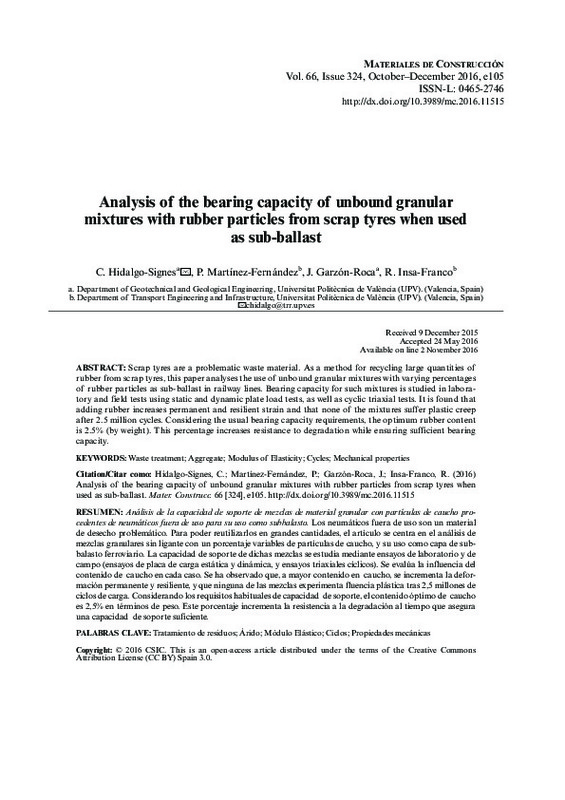Humphrey, D., & Blumenthal, M. (2010). The Use of Tire-Derived Aggregate in Road Construction Applications. Green Streets and Highways 2010. doi:10.1061/41148(389)25
Wolfe, S. L., Humphrey, D. N., & Wetzel, E. A. (2004). Development of Tire Shred Underlayment to Reduce Groundborne Vibration from LRT Track. Geotechnical Engineering for Transportation Projects. doi:10.1061/40744(154)62
Salgado, R., Yoon, S., & Siddiki, N. (2003). Construction of Tire Shreds Test Embankment. doi:10.5703/1288284313165
[+]
Humphrey, D., & Blumenthal, M. (2010). The Use of Tire-Derived Aggregate in Road Construction Applications. Green Streets and Highways 2010. doi:10.1061/41148(389)25
Wolfe, S. L., Humphrey, D. N., & Wetzel, E. A. (2004). Development of Tire Shred Underlayment to Reduce Groundborne Vibration from LRT Track. Geotechnical Engineering for Transportation Projects. doi:10.1061/40744(154)62
Salgado, R., Yoon, S., & Siddiki, N. (2003). Construction of Tire Shreds Test Embankment. doi:10.5703/1288284313165
Yoon, S., Prezzi, M., Siddiki, N. Z., & Kim, B. (2006). Construction of a test embankment using a sand–tire shred mixture as fill material. Waste Management, 26(9), 1033-1044. doi:10.1016/j.wasman.2005.10.009
Sol-Sánchez, M., Thom, N. H., Moreno-Navarro, F., Rubio-Gámez, M. C., & Airey, G. D. (2015). A study into the use of crumb rubber in railway ballast. Construction and Building Materials, 75, 19-24. doi:10.1016/j.conbuildmat.2014.10.045
Hidalgo Signes, C., Martínez Fernández, P., Medel Perallón, E., & Insa Franco, R. (2014). Characterisation of an unbound granular mixture with waste tyre rubber for subballast layers. Materials and Structures, 48(12), 3847-3861. doi:10.1617/s11527-014-0443-z
8. PF-7 (2006) Pliego de Prescripciones Técnicas Generales de Materiales Ferroviarios PF-7: Subbalasto (General Technical Specifications for Railway Materials PF-7: Sub-ballast). Spanish Ministry of Public Works and Transport, Madrid. (In Spanish).
10. Panadero, C.; Sanz, J.L. (2010) Análisis de las propiedades del sub-balasto: Contradicciones y procesos que afectan a su función (Analysis of sub-ballast properties: Contradictions and processes that affect their performance). Revista Ingeopres 196, 14–21. (In Spanish).
12. Santiago, E.; García, J.L.; González, P. (2010) Comparación de diferentes métodos de control de compactación del subbalasto (Comparison of different sub-ballast compaction control methods). CEDEX Geotechnical Laboratory, Madrid. (In Spanish).
Tompai, Z. (2008). Conversion between static and dynamic load bearing capacity moduli and introduction of dynamic target values. Periodica Polytechnica Civil Engineering, 52(2), 97. doi:10.3311/pp.ci.2008-2.06
17. Melis, M. (2006). Terraplenes y Balasto en Alta Velocidad Ferroviaria (Embankment and ballast in high speed railways). Revista de Obras Públicas 3464, 7–36. (In Spanish).
Werkmeister, S., Dawson, A. R., & Wellner, F. (2005). Permanent Deformation Behaviour of Granular Materials. Road Materials and Pavement Design, 6(1), 31-51. doi:10.1080/14680629.2005.9689998
Cerni, G., Cardone, F., Virgili, A., & Camilli, S. (2012). Characterisation of permanent deformation behaviour of unbound granular materials under repeated triaxial loading. Construction and Building Materials, 28(1), 79-87. doi:10.1016/j.conbuildmat.2011.07.066
Speir, R., & Witczak, M. (1996). Use of Shredded Rubber in Unbound Granular Flexible Pavement Layers. Transportation Research Record: Journal of the Transportation Research Board, 1547, 96-106. doi:10.3141/1547-14
24. Santamarina, J.C.; Klein, K.A.; Fam, M.A. (2001) Soils and Waves. Particulate Materials. Behavior, Characterization and Process Monitoring. John Wiley & Sons Ltd., Baffins Lane, Chichester.
25. Pe-a, M. (2003) Tramos de ensayo de vía en placa en la línea del corredor del Mediterráneo para su explotación a alta velocidad (Slab track test sites in the Mediterranean Corridor for high speed use). Revista de Obras Públicas 3431, 57–68. (In Spanish).
Cecich, V., Gonzales, L., Hoisaeter, A., Williams, J., & Reddy, K. (1996). Use of Shredded Tires as Lightweight Backfill Material for Retaining Structures. Waste Management & Research, 14(5), 433-451. doi:10.1177/0734242x9601400503
[-]









